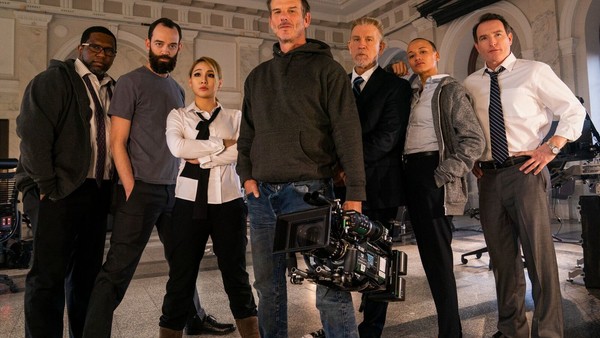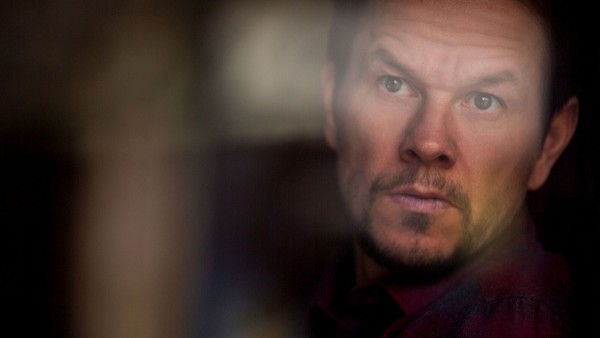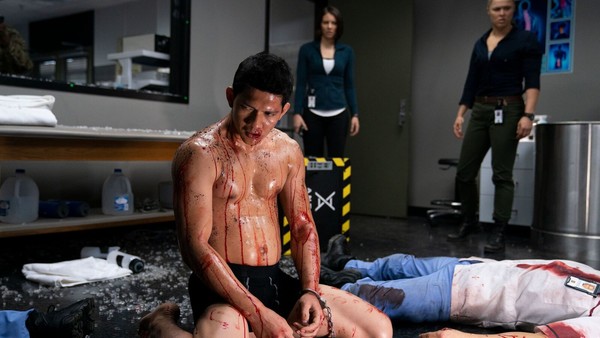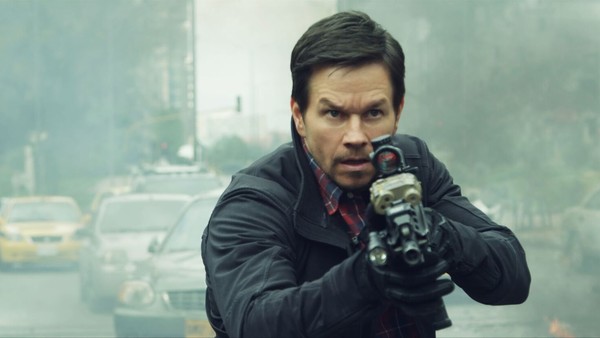Mile 22: Exclusive Interview With Director Peter Berg
So, what draws him back to Mark Wahlberg every time?

In Mile 22, the new action-packed thriller from Peter Berg, Mark Wahlberg stars as Jimmy Silva, the leader of an elite paramilitary team charged with transporting foreign intelligence asset Li Noor (The Raid’s Iko Uwais, here in his first major Hollywood role), from the relative safety of a US Embassy in Southeast Asia to an airfield for extraction – a distance of 22 miles from the city center.
Silva’s mission, of course, proves hardly a walk in the park. With Noor holding the key to encrypted information needed to prevent an imminent terrorist attack in exchange for safe transport to a refuge in the US, Silva’s team (featuring Ronda Rousey and The Walking Dead’s Lauren Cohan), must fight their way, mile by mile, through a dangerous urban landscape as local forces close in, determined to prevent his escape.
Mile 22 marks the fourth collaboration between Berg and Mark Wahlberg (a fifth film, Wonderland, is currently in preproduction). Their first pairing came in 2013 with the critically acclaimed, Lone Survivor, featuring Wahlberg as Marcus Luttrell in the true-story of an ill-fated US Navy SEAL mission in Afghanistan. Their follow-up, 2016’s Deepwater Horizon, cast Wahlberg as Mike Williams, the last man to escape the infamous BP oil rig, followed by Patriots Day (also released in 2016), a gripping account of the 2013 Boston Marathon bombing and its aftermath.
While the new movie marks a departure from the duos previous focus on true-life stories, the action-packed thriller is nevertheless infused by the real-world culture of special ops forces, with an overall aesthetic from Berg that eschews CGI spectacle for the grit of close-quarters combat.
Berg met with the press in Los Angeles where he discussed the making of the film and his ongoing creative partnership with Mark Wahlberg.
What is it about working with Mark Wahlberg that keeps you coming back for more?
I think he’s just a very talented actor - that’s a given. But he’s also like a brother. We get along very well. We have similar tastes in life. We like the same sports, we like the same wine, we have kids the same age. Our work ethics are similar. And so there’s a great affection and trust which makes for a fun work environment.
And I believe it should be fun to go to work every day. I work a lot. And I’ve been on film sets where there’s a lot of divisiveness and contention, creative heat and all that stuff. That can work for some people, but for me that’s a bunch of bullsh*t. I like to have fun. This is what I choose to do with my life and I plan on doing it for a long time… I want it to be good work, I want to have fun doing it, and that’s Mark too.

What’s your collaboration like on set?
As someone who grew up acting, I try to be very cognizant of character... Sometimes I succeed, sometimes I fail, and often times it’s somewhere in between… People ask why we keep working together. Well, Mark for me falls into a sweet spot where I can trust him to either figure out things that I’m not seeing as far as character goes - whether it’s Marcus Latrell or Mike Williams or Silva, the character he’s playing in this.
He’s very vigilant about coming to me and making sure that I’m paying attention. If I’ve taken my eye off it because I’m focused on some action or some improv or whatever else gets my attention, Mark is very good [at] saying, “Maybe you should look at this...” Also he’s very selfless, because he’ll do that with other characters. He’ll come up to me and say, “He should say this… He should do this…” For me that’s a partnership. These films may not be as rich in character as other filmmakers’ and more action-heavy, but one of the things that I value about Mark is he’ll constantly be like, “Character, character, character…”
That creates a balance that works for me aesthetically.
Why did the two of you want to make this film, and why the break from true stories?
Having done three true-stories, we wanted to do something [different] for many different reasons. We both saw The Raid and the sequel to it and felt that Iko Uwais is so unique and so talented, and brings so much art to these combat films, that it would be really fun for us to work with him. And it was like, ‘Okay this could be perfect.’ We wanted to do something fictional. I had an idea for this tight little action film… We figured if we could get him, we’d do it, and we were lucky to get him.

What was it like working with Iko Uwais?
One of the things that I found really interesting was that Iko came with some of his guys from Indonesia. And he had to work with some pretty accomplished American stunt guys who are like, ‘We have our way of doing things.’ And here comes Iko… Everyone was sort of sniffing each other out at first and my hope was that that these guys would see that there’s something that they could learn [from him].
I wasn’t sure that it would go that way. I’ve seen films where stunt guys, who were pretty aggro, macho guys, can bump heads. But Iko disarmed them all so quickly. Because he’s such a hardworking, original-thinking artist with this stuff, they were just like, “Go…” They let Iko take the lead. And it was a beautiful thing to watch. These tough fighters agreeing that this guy really does know what he’s doing, and that they wanted to learn from him.
Did anyone ever get hurt?
We actually take safety very, very seriously. We have an extraordinary crew; these guys were all well trained. We joke around. But we don’t play around with safety. So, no, fortunately, nobody was hurt.
The film’s opening sequence features a clip of Donald Trump and Kim Jong-un, amongst others, pulled from the latest headlines. What’s the underlying idea behind the sequence?
This is a work of fiction. But it’s about the CIA’s Ground Branch (part of the agency’s Special Activities Division, responsible for covert operations) which really exists. They really are ‘the third option.’ So we talked to a company that does opening credits, and I’m like, ‘Let’s do something that feels like it’s got one hand in reality.’ That credit sequence was me saying… “Can we do something that feels current? That makes people go, ‘Wait a minute. Was the Ground Branch behind this? Suddenly Trump and North Korea are sitting down shaking hands? Maybe something else was going on…’”
Though the film is fictional, it seems like you wanted some basis in reality? Is that something that carries over from your previous films?
I think so. I mean, for me, like Mark [has] said… our idea of fun might be different than others. Some people might go make The Lion King when they want to have fun. We made a pretty violent action film. But no matter what I do at this point, I’m always going to try and put one hand into the real world, just because that helps ground it for me, and it helps me make sense of it. Fantasy filmmaking isn’t my personal thing. We wanted to make an action film, but I needed something to ground it with, and that was literally Ground Branch. And the more research I did on Ground Branch, the more grounded the movie felt.

What was it like shooting in Bogota?
PB: We were a bit skeptical, particularly our production guys, about how feasible shooting big action sequences, shooting anything really in Colombia was. A good friend of mine, Eric Newman produces Narcos (Netflix; 2015-2017)… Eric had been very positive about his experience, but it was on smaller scale… [For this] we were talking about gun fights and explosions right in downtown Bogota.
So we went down there and met with President Santos who was relieved that it wasn’t a film about cocaine. But then quickly [we] had to be like, “But we are going to blow up everything in your city…” (Laughs)… I think they saw that we were responsible and professional. And we truly had a wonderful time. The Colombians couldn’t have been nicer…
Do you want audiences to enjoy the film as pure entertainment, or would you like them to leave the theater thinking about what’s going on in the world?
I think both. In the case of Mile 22, I want people to go in, and for an hour and forty minutes to just get hit. To just not breathe and put their phones down and go along for the ride. This is a visceral experience and that’s what I like when I go and see an action-film. I want to just forget about everything and just be pulled into it. That’s the primary goal. If afterwards, people google Ground Branch, and go, “Holy sh*t this stuff really exists…” Fantastic.
Were you happy, on the whole, with the move from nonfiction to fiction or was there something missing for you?
There were things I missed. It’s addictive when you do something almost journalistic. When we’re making a movie like Friday Night Lights or Lone Survivor or Deepwater Horizon and you get to go like a journalist and meet these people and uncover these stories and realize, “Oh my god you did this..?” That’s an addictive feeling. And so I miss that. I got to do some of that by interviewing ex-Ground Branch and some current CIA for this movie.
But when you do those real movies, you have to show the film to all the families of people who died. Their parents, their children, their brothers. And that’s heavy. It’s intense and can be very emotionally draining. I’d be lying if I said there wasn’t less of that stress, talking to Iko about doing some great fights and blowing stuff up. So, I don’t miss that right now. I think I’ll go back to that again, in my career. But it was nice to just make an action movie.
Mile 22 is in cinemas now.